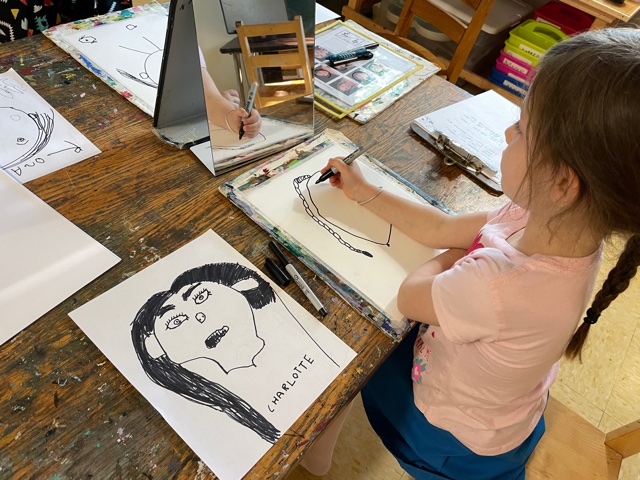Since the start of COVID-19, our Art Studio and Music Studio experiences have been modified, mostly happening outdoors. With this new school year we are so excited to be back in the studio!
For the children in the Cloud Room, our Kindergarten classroom, many have been in the Art Studio before, but it’s been nearly two years. Though my intention for our time together was to focus on studies and self-portraits, it was important for all of the children to tour the studio and spend some time examining the areas and materials before we got down to work.

Before the children even began to draw, we had a conversation about what our process would be like. I invited them to examine their faces in a mirror before lifting up a pen, and I introduced them to the idea of creating a study of their face. The study could then be used to try out different ways of drawing particular features, and would give the children the opportunity to decide what they liked about their work, and what (if anything) they would change.
The concept of creating a study drawing often takes pressure away from children who may be concerned about “getting it right” or having their work match their ideas about how their work should look. It also gives the children a way to look at their work with a discerning yet non-judgemental eye. It’s a way to take creative risks. We talked about how artists may make one study drawing or many study drawings before moving on to their final piece. This concept seemed to interest the children and we decided as a group to continue working in the way while in the studio.
Student: “When I paint at home…I just paint. I don’t really think about it and I don’t really plan. Sometimes I like that but sometimes if I’m trying something hard, I don’t. This is a good idea.”

Another thing that we discussed was the idea of using mathematical concepts (fractions) as a way to look at our faces and draw them. As counting lines, measurements, and simple fractions are something that the children have begun to explore in their classroom, using them to think about the quadrants of our faces- and in which quadrant each feature belonged in, seemed to make sense to the children. One child noticed that quadrant sounded like cuatro, the Spanish word for four and that it would help her remember that there are four quadrants that make up her one face.
Student: “I already know I want to make my eyes smaller. I don’t want it to be too big.”

Student: “In my first picture I made my hair shorter. In my real picture, my hair is longer. See? It goes past my chin.”

After the children made a study drawing and decided to move forward on their final piece, they spent some time considering which color and variation of this color they should use as their skin tone. We talked about our different skin shades and ways to create the variations in tone that we observe. Five different base skin tones were mixed up, and I showed the children how they could make the colors darker or lighter as need be. The children chose their colors carefully and they experimented with these adding water or more pigment to achieve their desired shade.
Student: “I think I’m a little bit this but not exactly the same. It matches part of my arm but not on the inside. Maybe I’ll do some of my arm this and some a little lighter.”

Student: “I made my teeth black because I wanted to make them black and because the inside of my mouth is dark.”

Student: “In my study I didn’t know how to make my braid…but, you know what? I figured it out. I thought about how it looks in my head, then I did it. I really wanted to put it on.”


Reflection by Kelly Blondin, Art Specialist

You must be logged in to post a comment.